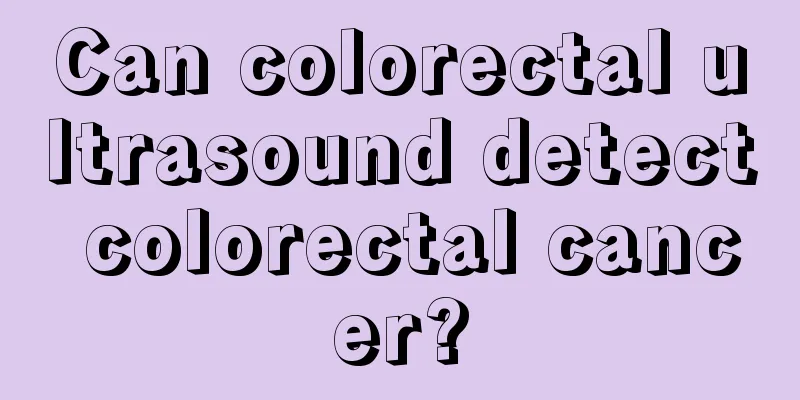Can colorectal ultrasound detect colorectal cancer?

|
With the improvement of living standards, the quality of life has also greatly improved. Many people choose high-calorie, high-fat foods. For young people, crude fiber and coarse grains seem to have withdrawn from people's lives. This has led to the occurrence of various diseases. Colorectal cancer is one of them. How to check for colorectal cancer, which has a very high incidence rate! Let us introduce it to you in detail below. 1. Laboratory examination Blood routine, complete biochemistry (liver and kidney function + serum iron), stool routine + fecal occult blood and other laboratory tests can help understand whether the patient has iron deficiency anemia, liver and kidney function and other basic conditions. Testing for blood tumor marker carcinoembryonic antigen (CEA) can help diagnose tumors. In patients with colorectal cancer, high CEA levels do not mean that there is distant metastasis; in a few patients with metastatic tumors, CEA levels are not elevated. 2. Endoscopic examination Colonoscopy is to insert a fiber colonoscope into the ileocecal region at the beginning of the colon to examine the colon and rectal cavities, and perform biopsies and treatments during the examination. Colonoscopy is more accurate than barium enema X-rays, especially for small colon polyps, which can be removed by colonoscopy and confirmed by pathology. Removal of benign polyps can prevent them from turning into colorectal cancer, and cancerous polyps can help clarify the diagnosis and treatment. 3. Biopsy and exfoliative cytology Biopsy is of decisive significance for the diagnosis of colorectal cancer, especially early cancer and polyp cancer, as well as for differential diagnosis of lesions. It can clarify the nature, histological type and malignancy of the tumor, judge the prognosis and guide clinical treatment. Exfoliative cytology has high accuracy, but the sampling is cumbersome, and it is not easy to obtain satisfactory specimens, so it is rarely used in clinical practice. Colorectal cancer must be differentiated from other intestinal lesions with symptoms such as abdominal mass, abdominal cramps, rectal bleeding or changes in bowel habits, including benign tumors or polyps of the colon such as adenoma, inflammatory polyps, juvenile polyps, intestinal wall lipoma, hemangioma, leiomyoma, etc.; various inflammatory diseases of the colon such as ulcerative colitis, Crohn's disease, amoebic enteritis, Japanese schistosomiasis, intestinal tuberculosis, colon diverticulitis, inflammatory masses around appendicitis, radiation enteritis, venereal lymphogranuloma, etc., benign rectal and anal canal diseases such as hemorrhoids, anal fissures, anal fistulas, etc. Others such as intussusception, sigmoid colon fecal mass storage and rare intestinal endometriosis are also included in the differentiation. Since the symptoms of colorectal cancer are not specific and overlap with the clinical manifestations of various intestinal diseases, active diagnosis is often used in clinical diagnosis, and exclusion diagnosis is rarely used. For suspected patients, detailed medical history is inquired and careful examination is performed, and a clear diagnosis can often be made with fiber colonoscopy or X-ray barium meal enema and pathological biopsy. Colon cancer should be mainly differentiated from colon inflammatory diseases, including intestinal tuberculosis, Crohn's disease, ulcerative colitis, schistosomiasis granuloma, amebiasis granuloma, etc. In addition, it should be differentiated from primary liver cancer, biliary tract disease, and appendix abscess. Rectal cancer should be differentiated from bacillary dysentery, amoebic dysentery, hemorrhoids, schistosomiasis, chronic colitis, etc. Through the above introduction, we have learned about the examination of colorectal cancer and how to make a differential diagnosis. I hope that friends can understand their own physical changes through learning, and choose the appropriate examination method according to the severity of their condition. Colorectal cancer is one of the malignant tumors, which brings great physical harm to patients. Therefore, friends in life must develop good eating habits, which can also effectively reduce the occurrence of colorectal cancer. |
<<: What are the methods for colorectal cancer examination
>>: What are the methods for colorectal cancer examination
Recommend
Things to note when doing calf muscle reduction surgery
Calf muscle reduction surgery is actually a surge...
How much is the cost of treating advanced colorectal cancer
How much is the cost of treating advanced colorec...
What are the symptoms of jaw lymphoma
Mandibular lymphoma is a very common disease in c...
How to clean a burnt pot bottom
When you are busy in the kitchen, it is inevitabl...
What to do if your hands feel numb
Many people often experience numbness in their ha...
What is the treatment for cerebral vasospasm
I believe that many friends have not heard of the...
Understanding the typical symptoms of prostate cancer
As for the specific symptoms of prostate cancer, ...
The difference between sardines and saury
Sardines and saury are two different fish. Sardin...
What symptoms do lung cancer patients usually have? The three most common symptoms of lung cancer patients
Lung cancer is not a uncommon disease, especially...
What are the typical symptoms of pituitary tumors
Pituitary tumor is one of the main tumors occurri...
What does open wound mean?
An open wound is a wound that bleeds outward, whi...
The harm of sebaceous adenoma, sebaceous adenoma is very harmful
Generally speaking, sebaceous adenoma often occur...
How long does it usually take to recover from nasopharyngeal cancer
The recovery time of rhinitis is very long. Gener...
Where is the root of the nose
We can massage the root of the nose with our hand...
What skin tone is suitable for pink skin
Many little girls like pink colors because they t...









